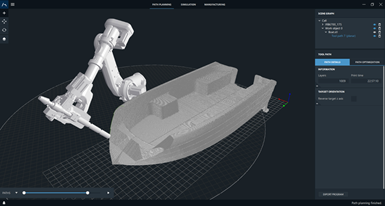Adaxis raises €1 million to combine 3D printing, industrial robotics
AdaOne software platform to be launched in 2022 supports automated, large-scale 3D printing with metals, plastics, composites and concrete to advance large-scale manufacturing.

Photo Credit: Adaxis
Adaxis (Bidart, France), a robotics software company launched in early 2021, has raised more than €1 million in pre-seed funding from the European Institute of Innovation and Technology (EIT), Newfund Capital, SkalePark and regional grants. With its new software platform, AdaOne, which supports 3D printing using metals, plastics, composites and concrete, Adaxis aims to more quickly and easily program commercially available industrial robots as flexible, large-scale manufacturing cells based on 3D printing.
AdaOne covers all the tasks required to manufacture a part Adaxis contends, from program generation to real-time process supervision and multiphysics numerical simulation. The software is scalable and can program robots of any size, enabling printable volumes up to tens of cubic meters. This capability gives companies the power to set up local and on-demand production of highly advanced parts, reducing the need for storage, transportation and logistics.
According to Adaxis, large-scale polymer-based additive manufacturing (LSPAM) is currently an actively pursued technology for scaled-up composite parts and tooling applications. In low-medium performance applications using discontinuous carbon fiber-reinforced polymers (CFRP), AM’s design flexibility is able to reduce the number of manufactured parts and offers good assembly consolidation. For high-performance applications, the use of LSPAM to develop a high-performance low-cost mold may increase its adoption in both aerospace and automotive sectors, where out-of-autoclave tooling applications are being explored. Finally, LPSAM is useful for tailoring molds with embedded heating elements and helps designers use composites for parts which were not previously possible due to cost/manufacturing constraints. In short, Adaxis feels its AdaOne technology is an attractive prospect for composites fabricators.
Adaxis was launched at the beginning of 2021 by Henri Bernard, Guénolé Bras, Emil Johansson and Vasan Churchill, following years of applied research into using industrial robotics for advanced manufacturing at ESTIA and RISE Research Institutes of Sweden. The team first met during a European Union (EU) co-funded collaborative research project where they found a shared vision to bring 3D printing and automation together.
“The founders have spent the last five years working on developing additive manufacturing processes and robotic algorithms. With Adaxis, our mission is to be a key catalyst for the industrialization and large-scale use of this technology,” says Emil Johansson, director of Adaxis. “Closing our first round of funding and partnering with strong, long-term investors allows us to take the next step on this journey.”
AdaOne’s proprietary algorithms for multi-axis toolpaths enable the creation of parts which could previously not be manufactured, according to the company. Large, complex parts can be realized without assembly steps and with minimal material waste. It is also possible to perform repair of damaged parts by allowing material to be deposited on existing 3D surfaces. Customized deposit orientation improves surface quality and mechanical strength by avoiding traditional horizontal layers.
Currently supported by the Nouvelle Aquitaine region and ADI, Adaxis has been awarded the first European prize in the “Boost Up!” innovation competition, and was also labeled a Deep Tech company by French public investment bank Bpifrance.
Related Content
-
Eaton developing carbon-reinforced PEKK to replace aluminum in aircraft air ducts
3D printable material will meet ESD, flammability and other requirements to allow for flexible manufacturing of ducts, without tooling needed today.
-
Robotized system makes overmolding mobile, flexible
Anybrid’s ROBIN demonstrates inline/offline functionalization of profiles, 3D-printed panels and bio-based materials for more efficient, sustainable composite parts.
-
Hybrid process marries continuous, discontinuous composites design
9T Labs and Purdue applied Additive Fusion Technology to engineer a performance- and cost-competitive aircraft bin pin bracket made from compression-molded continuous and discontinuous CFRTP.

















